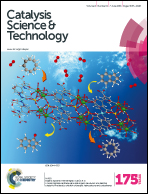Enhancement of photocatalytic hydrogen formation under visible illumination by integrating plasmonic Au nanoparticles with a strongly catalytic Ni3S2/carbon nanotube composite†
Abstract
Photocatalytic production of H2 by water splitting gives a promising solution to growing demands for clean and sustainable energy. In this work, we demonstrate the first example of using localized surface plasmon resonance (LSPR) of gold nanoparticles (AuNPs) to enhance the activity of a dye-sensitized photocatalytic system toward hydrogen evolution. For the synthesis of the photocatalyst, the AuNPs and Ni3S2 were co-deposited onto the conductive backbones of multi-walled carbon nanotubes (AuNPs@NiS@CNT) using a glucose-assisted hydrothermal method. The activity of AuNPs@NiS@CNT has been studied by sensitizing the photocatalyst with Erythrosin Yellowish (ErY) in a solution of the sacrificial reagent. It is found that AuNPs@NiS@CNT shows superior photocatalytic activity to the AuNP-free photocatalyst due to the fact that plasmonic AuNPs can significantly enhance the light-harvesting characteristics of ErY sensitizers. Furthermore, the photocatalytic activity of AuNPs@NiS@CNT nonlinearly increases with AuNP loading content and the optimal AuNP loading in the photocatalyst is 1 wt%. Compared with the AuNP-free photocatalyst, the addition of 1 wt% AuNPs to the photocatalyst leads to a 127% increase in the amount of hydrogen evolved. In addition to the contribution from the LSPR of AuNPs, the photocatalytic enhancement of AuNPs@NiS@CNT can be ascribed to the fact that the excellent electron transport properties of CNTs allow the electrons from photoexcited ErY molecules to efficiently transfer to the Ni3S2 catalyst and simultaneously prevent charge recombination. More importantly, by activating AuNPs(1 wt%)@NiS@CNT in a 1 M KOH solution for 3 days, the amount of evolved hydrogen in 3 h can be further increased to 1110 μmol. This KOH treatment may remove the partial amorphous carbon on the Ni3S2 surface to increase the number of active sites for photocatalytic hydrogen evolution. Because AuNPs@NiS@CNT shows reasonable stability and a high apparent quantum yield of 8.1%, it has great potential to be a low-cost photocatalyst for hydrogen evolution.


 Please wait while we load your content...
Please wait while we load your content...